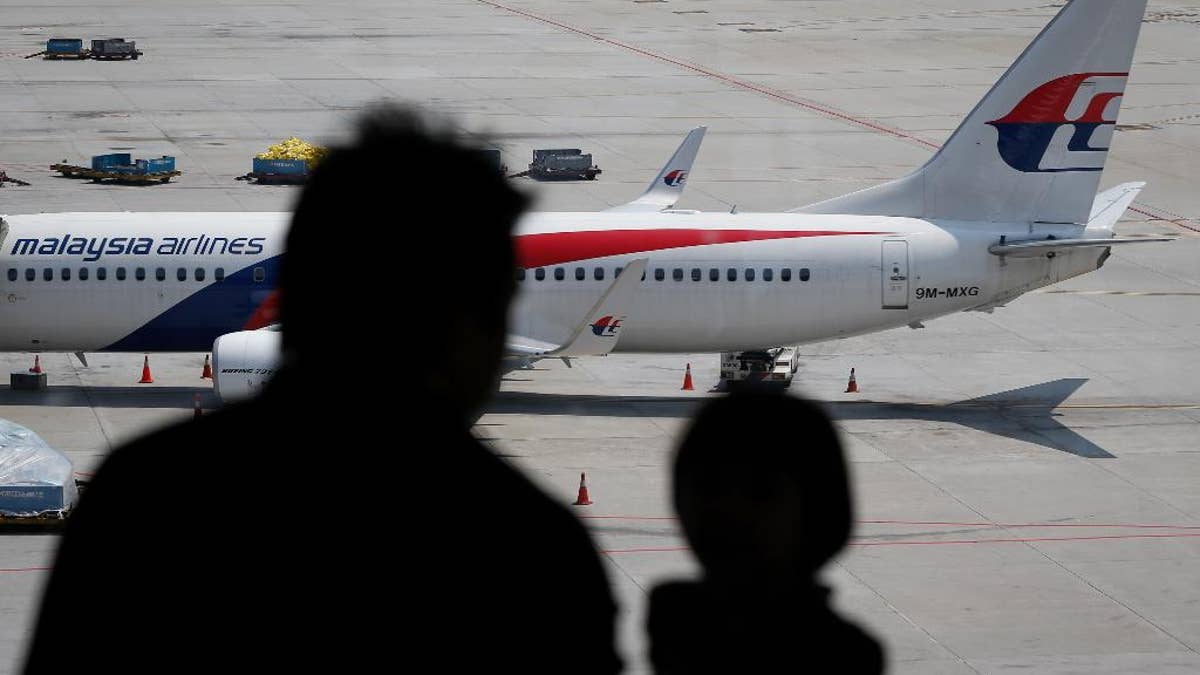
In this Friday, Feb. 27, 2015 photos, visitors look out from a viewing gallery as a Malaysia Airlines plane sits in the tarmac at the Kuala Lumpur International Airport (KLIA) in Sepang, Malaysia. After a year of unprecedented calamity for the Southeast Asian carrier, Malaysia Airlines is aiming to return to profitability by 2017 with a drastic $1.7 billion overhaul that includes cutting nearly a third of its staff. (AP Photo/Vincent Thian) (The Associated Press)
KUALA LUMPUR, Malaysia – After a year of calamity, Malaysia Airlines is shrinking to survive.
The disappearance of Flight 370 one year ago, combined with the downing of Flight 17 over a rebel held area of eastern Ukraine four months later, brought the already financially struggling flag carrier to its knees.
The government, which owned most of the airline, took 100 percent ownership and removed it from the Malaysian stock exchange last year. The airline is now aiming to return to profitability by 2017 with a drastic $1.7 billion overhaul that includes cutting nearly a third of its staff.
Key to the plan is a new CEO, Christoph Mueller, a turnaround specialist who led a successful revival of Ireland's Aer Lingus. His new bosses hope he'll be able to pull off a similar feat at Malaysia Airlines though analysts say success is far from guaranteed because of the political baggage of being a state-owned company. At least four other major restructurings of Malaysia Airlines since 2001 have failed.
"There's no doubt that it's got more challenges than many, because you're dealing with a company that's in a poor financial state, you've got the political interference, the backlash of the incidents," said John Strickland, director of JLS, an airline industry consulting company.
The challenge of the restructuring is compounded by rapid changes in the aviation industry in Asia, where low cost carriers are proliferating to serve the growing ranks of middle class consumers.
The disasters that brought Malaysia Airlines to the brink of financial collapse served to underline the weakness of it and other full-service carriers in the region. They face stiff competition from a wave of budget upstarts including Malaysia's AirAsia, Indonesia's Lion Air, Tigerair and Scoot from Singapore, and Qantas offshoot Jetstar.
Even Malaysia Airlines has its own low-cost offshoot, Firefly. Mueller may be keen to use it as a testing ground for new ideas, given his track record at Aer Lingus, where he responded to competition from no-frills airline Ryanair by mimicking as many of its practices as possible.
The changes, which blurred the distinction between Lingus and Ryanair, include shortened airplane turnaround times at the gate and charging for seat selection, checked bags and food and drinks.
Aer Lingus' net profit since its 2006 stock flotation has wobbled between modest profits and losses as the company took financial hits for strikes, shutdowns, mass cancellations and pension gap payoffs in order to avoid more strikes.
The result is that he's turned an airline that was near death into an attractive takeover target for Ryanair and British Airways parent IAG simply by getting it through a period of massive upheaval.
A similar outcome might be in store at Malaysia Airlines. Khazanah Nasional, the Malaysia sovereign investment fund that owns the airline, said it may consider selling some or all of its stake to private investors after relisting shares within a planned three to five years.
Aer Lingus and Khazanah Nasional declined interview requests for Mueller, who started his new job on Sunday.
In a quarterly update released Monday, Khazanah said the overhaul of Malaysia Airlines is on track. The airline is preparing to cut 6,000 of its 20,000 employees. It's also planning to expand seats on Asian routes by 5 percent but is reviewing European and Mideast routes with a view to ending some.
The company said it also won a temporary 25 percent reduction on its monthly catering bill as it renegotiates its supplier contract.
The cuts are vital to stem the losses at the airline. In its last financial result as a listed company, the airline reported that third quarter losses widened 53 percent from a year earlier to $170.3 million. That brought its loss in the first nine months of last year to $368 million.
Asian aviation experts have urged changes at the airline but say there is a risk it could shrink too much as it battles to compete with the low-cost crowd.
They say there's still room for legacy carriers in Asia, though they need to concentrate on routes and destinations where they can make money, mainly to capital cities and business and finance hubs.
"In Asia, you've still got a lot of low-income countries where price is a major factor," said Andrew Herdman, director-general of the Association of Asia-Pacific Airlines. "It's a challenge for full-service carriers in Asia to restructure and be more efficient to narrow that productivity and cost gap with budget carriers."
Herdman said a "pure no-frills model is not the answer" for airlines trying to compete. The bulk of their revenue still comes from medium and long-haul fares and airlines need two to three classes tailored to the needs of different types of passengers.
An unexpected helping hand for the airline has come from the collapse in the price of oil over the past year.
Mohshin Aziz, aviation analyst at Maybank Kim Eng Securities, said the airline's jet fuel bill, which last year amounted to 6.3 billion ringgit ($1.7 billion), will be cut in half this year, which alone will help it return to profitability.
But he also worried it might reduce the pressure for change.
Mohshin said he sees a "zombie" future for the airline which will be "alive but barely."
"They will just be in this perpetual bureaucratic tug of war between the employees, the government and the management."
____
Chan reported from Hong Kong. Shawn Pogatchnik in Dublin contributed to this report.
